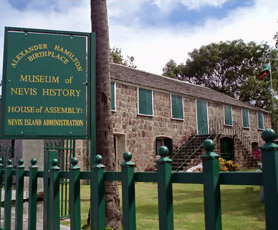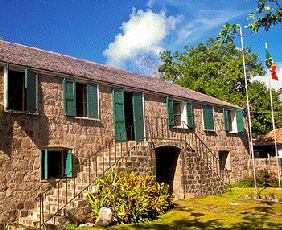Learn about the Beautiful Island of Nevis‚Äã‚Äã

Location
Nevis (pronounced nee'-vis) is part of the St. Kitts & Nevis Federation, an independent nation within the British Commonwealth. The Federation received its independence from Britain in 1983, and British influence is still strong. Nevis was presumably named by Christopher Columbus, who sailed by and landed on St. Kitts in 1493. Nevis comes from the Spanish word for snow; the name was inspired by white clouds around Nevis Peak.
Nevis is one of the Leeward Islands and lies about 200 miles south of Puerto Rico. (See a map of the Caribbean Sea here.) Nevis is slightly elongated, 7 miles long and 5 miles wide with an area of 36 sq. miles and is separated from St. Kitts by a narrow strait.
Economy
There is no agriculture left on Nevis beyond small farming; sugar production stopped long ago. The main source of income is tourism.
Culture
About 12,000 people live on Nevis, most of African descent. The official language is English. Nevis has a literacy rate exceeding 97% [the highest in the western hemisphere] and an average life expectancy of over 67 years.
The capital of Nevis is Charlestown. Nevisians are church-going people with Methodist, Baptist, Roman Catholic, Jehovah's Witnesses and other faiths represented.

History
Like all Carribbean islands, Nevis has a long history of battles, pirates, and hurricanes. In the late 17th and early 18th centuries, sugar production on Nevis surpassed most other Caribbean islands, making it a valuable possession and gaining it the name of "The Queen of the Caribees."


Enslaved Africans on Nevis fought against their enslavement in many ways. They tried to keep their African heritage alive in words, music, names and beliefs or customs. Some started rebellions, some ran away. Many runaways were caught and punishments were severe. Some, however, remained free.
Nevis comes from the Spanish word for snow; the name was inspired by white clouds around Nevis Peak.
First settled by the British in 1623, the islands became an associated state with full internal autonomy in 1967. The island of Anguilla rebelled and was allowed to secede in 1971. Saint Kitts and Nevis achieved independence in 1983. In 1998, a vote in Nevis on a referendum to separate from Saint Kitts fell short of the two-thirds majority needed. Nevis is once more trying to separate from the Saint Kitts.










 Left: A side view of the projected new Nevis Cultural Complex.
Right: The complex in the Nevis as it sits n...
Left: A side view of the projected new Nevis Cultural Complex.
Right: The complex in the Nevis as it sits n... 2/1/2013 the Nevis Cultural Complex logo was finalized. The logo design reflects the mesh tensile overhang that encompasses the complex and the c...
2/1/2013 the Nevis Cultural Complex logo was finalized. The logo design reflects the mesh tensile overhang that encompasses the complex and the c...










